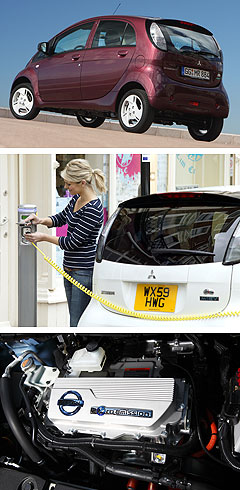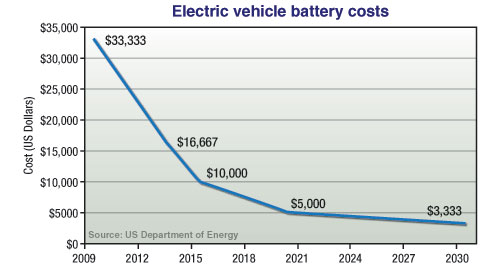Make / Model Search
News - Market Insight - Market Insight 2011Market insight: Batteries getting cheaper, betterEconomies of scale: EV batteries will become much cheaper over the next few years, according to the United States Department of Energy. US predicts car-makers can win the EV battle with major advances in batteries10 Jun 2011 ELECTRIC vehicle batteries will be 70 per cent cheaper by 2015 and 600 per cent more efficient by 2020, according to United States Department of Energy predictions. The US figures – shown to journalists by Mitsubishi Motors Australia Ltd (MMAL) to support its contention that plug-in motoring is the way of the future – reveal that batteries to power an electric car cost more than $33,000 in 2009, but those same batteries are expected to cost just $10,000 in 2015. By 2020, they are expected to be down to $5000, and just $3333 by 2030. At the same time, battery performance is expected to increase dramatically. The US department’s study shows that batteries required to propel an electric car 160km in 2009 weighed 333kg, but by 2015, that would be cut by about a third, to about 222kg, and then down to just 55kg between 2020 and 2030. According to Mitsubishi – which this week announced its all-electric i-MiEV city car would go on sale in Australia in August for about $50,000 – that equates to a 600 per cent increase in battery efficiency in little more than a decade. If correct, the US predictions point to all-electric cars with a far more practical range. MMAL vice president of corporate strategy Paul Stevenson predicts the practical range of EVs will grow from today’s 100km to about 200km by 2015.  Left: Mitsubishi i-MiEV static and charging shots. Below: Nissan Leaf EV motor. Left: Mitsubishi i-MiEV static and charging shots. Below: Nissan Leaf EV motor.He said economies of scale in battery production would also help to drive down the cost of such cars, with billions of dollars being poured into the industry. But Mr Stevenson said “bridging technologies” such as hybrids and plug-in hybrids would play a major role in the step towards full electrification, with Mitsubishi planning to launch such vehicles in the next two years. “That is when we get into real volume,” he said. Research published by Bloomberg predicts EVs will comprise 10 per cent of world new vehicle sales – about eight million units a year – by 2020. The report said China, with increasing restrictions on fossil-fuel cars and incentives on electric vehicles, is expected to lead the way with 2.2 million plug-in vehicles by that time – well ahead of the predicted US tally of 1.5 million a year. But China’s own government ‘road map’ has a target of 10 million “new-energy” vehicles by 2020, comprising hybrid, plug-in hybrid and full electric cars, trucks and buses. China has committed 100 million yuan ($15 billion) for “new-energy” vehicle development over the next 10 years, against $2 billion to $3 billion in the US where President Barack Obama has a target of one million plug-in cars by 2015. According to MMAL, the Australian government does not even have a strategy for EV roll-out in this country, let alone incentives. Mr Stevenson said China, the US, Canada, Japan and Europe all had established targets for EV volumes, technology standards and other essential factors governing this new form of motoring. He said Australia seemed to be “seriously lagging in government policy on all these things”. “Australia is the only market in which i-MiEV has been launched where there are no incentives or policies to support EV introduction,” he said. Mr Stevenson said the government seemed to be preoccupied by carbon pricing at the moment. “We can see from the growth of solar panels in Australia the impact subsidies can have,” he said. Mr Stevenson said governments could support the growth of EVs in other ways, by formulating targets, taking a stance on recharge points, traffic laws (such as London’s congestion charge) and parking spaces to encourage the shift. “What we need is a big bold statement by the government to say ‘yes, this is what we are going to do.”  Read more |
Click to shareMarket Insight articlesResearch Market Insight Motor industry news |












Facebook Twitter Instagram